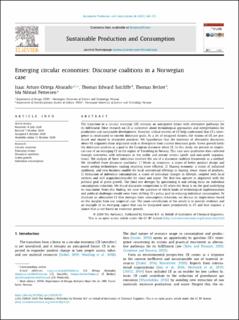| dc.contributor.author | Ortega Alvarado, Isaac Arturo | |
| dc.contributor.author | Sutcliffe, Thomas Edward | |
| dc.contributor.author | Berker, Thomas | |
| dc.contributor.author | Pettersen, Ida Nilstad | |
| dc.date.accessioned | 2020-10-27T08:53:13Z | |
| dc.date.available | 2020-10-27T08:53:13Z | |
| dc.date.created | 2020-10-23T12:33:11Z | |
| dc.date.issued | 2021 | |
| dc.identifier.citation | Sustainable Production and Consumption. 2021, 26C 360-372. | en_US |
| dc.identifier.issn | 2352-5509 | |
| dc.identifier.uri | https://hdl.handle.net/11250/2685158 | |
| dc.description.abstract | The transition to a circular economy (CE) remains an anticipated future with alternative pathways for its fulfillment. Most research on CE is normative about technological approaches and interpretations for production and sustainable development. However, critical reviews of CE help understand that CE’s emergence is constrained to current dominant goals. As a set of imagined futures, the visions of CE are produced and shared in discursive practices. We hypothesize that the existence of alternative discourses about CE originates from alignment with or divergence from current dominant goals. Green growth holds the dominant position as a goal in the European discourse about CE. In this study, we present an empirical case of an emerging CE in the region of Trøndelag in Norway. This case uses qualitative data collected through interviews with informants in the public and private sectors (profit and non-profit organizations). The analysis of these interviews involved the use of a discourse coalition framework as a method. We identified three discourse coalitions: 1) Waste as resources: a vision of better product design and waste sorting technologies making recycling more efficient. 2) Sharing economy: a vision of industrial symbiosis, and new business models for local commercial offerings in sharing, reuse, repair of products. 3) Reduction of individual consumption: a vision of individual changes in lifestyle, coupled with local services and skill acquisition/transfer for reuse and repair. The first two operate in alignment with the political goal of green growth. The third one diverges by questioning it and setting focus on individual consumption reduction. We found discursive competition in CE when the focus is on the goal underlying its enactment. From this finding, we raise the question of which kinds of technological implementation and political challenges would come from shifting CE’s policy goal to reducing individual consumption. To illustrate an alternative CE that emerges from consumption reduction, we discuss its implications based on the insights from our empirical case. The main contribution of the article is to provide evidence and an example of an emerging aspect that can be integrated more prominently in CE and that requires a stance that is not based on economic growth. | en_US |
| dc.language.iso | eng | en_US |
| dc.publisher | Elsevier | en_US |
| dc.rights | Navngivelse 4.0 Internasjonal | * |
| dc.rights.uri | http://creativecommons.org/licenses/by/4.0/deed.no | * |
| dc.title | Emerging circular economies: Discourse coalitions in a Norwegian case | en_US |
| dc.type | Peer reviewed | en_US |
| dc.type | Journal article | en_US |
| dc.description.version | publishedVersion | en_US |
| dc.source.pagenumber | 360-372 | en_US |
| dc.source.volume | 26C | en_US |
| dc.source.journal | Sustainable Production and Consumption | en_US |
| dc.identifier.doi | 10.1016/j.spc.2020.10.011 | |
| dc.identifier.cristin | 1841799 | |
| dc.description.localcode | © 2020 The Author(s). Published by Elsevier B.V. on behalf of Institution of Chemical Engineers. This is an open access article under the CC BY license (http://creativecommons.org/licenses/by/4.0/) | en_US |
| cristin.ispublished | true | |
| cristin.fulltext | original | |
| cristin.qualitycode | 1 | |

